TOYOTA C-HR 2019 Owners Manual (in English)
Manufacturer: TOYOTA, Model Year: 2019, Model line: C-HR, Model: TOYOTA C-HR 2019Pages: 532, PDF Size: 10.35 MB
Page 351 of 532
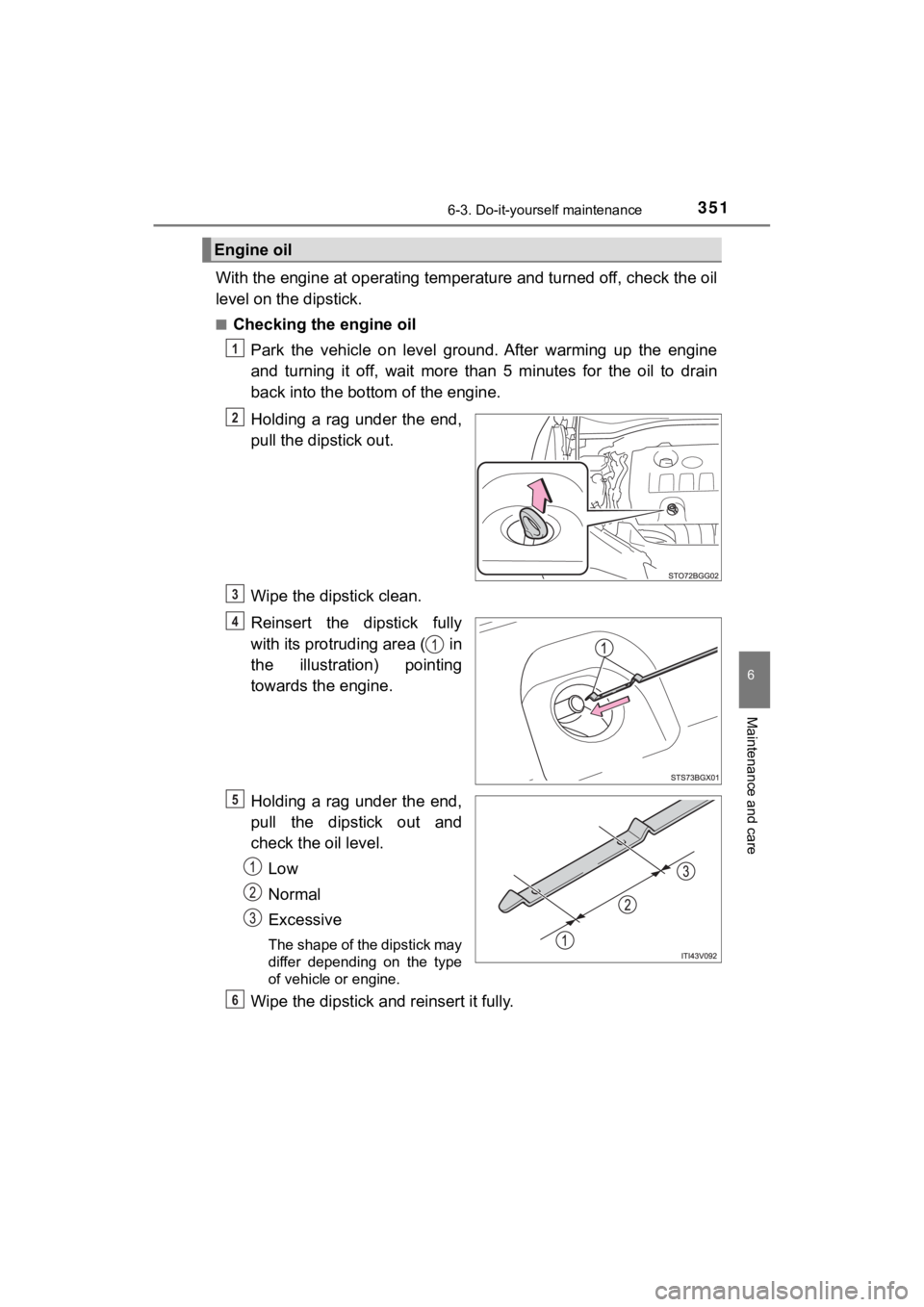
3516-3. Do-it-yourself maintenance
6
Maintenance and care
C-HR_OM_USA_OM10569U
With the engine at operating temperature and turned off, check the oil
level on the dipstick.
■Checking the engine oil
Park the vehicle on level ground. After warming up the engine
and turning it off, wait more than 5 minutes for the oil to dra in
back into the bottom of the engine.
Holding a rag under the end,
pull the dipstick out.
Wipe the dipstick clean.
Reinsert the dipstick fully
with its protruding area ( in
the illustration) pointing
towards the engine.
Holding a rag under the end,
pull the dipstick out and
check the oil level.
Low
Normal
Excessive
The shape of the dipstick may
differ depending on the type
of vehicle or engine.
Wipe the dipstick and reinsert it fully.
Engine oil
1
2
3
4
5
6
Page 352 of 532
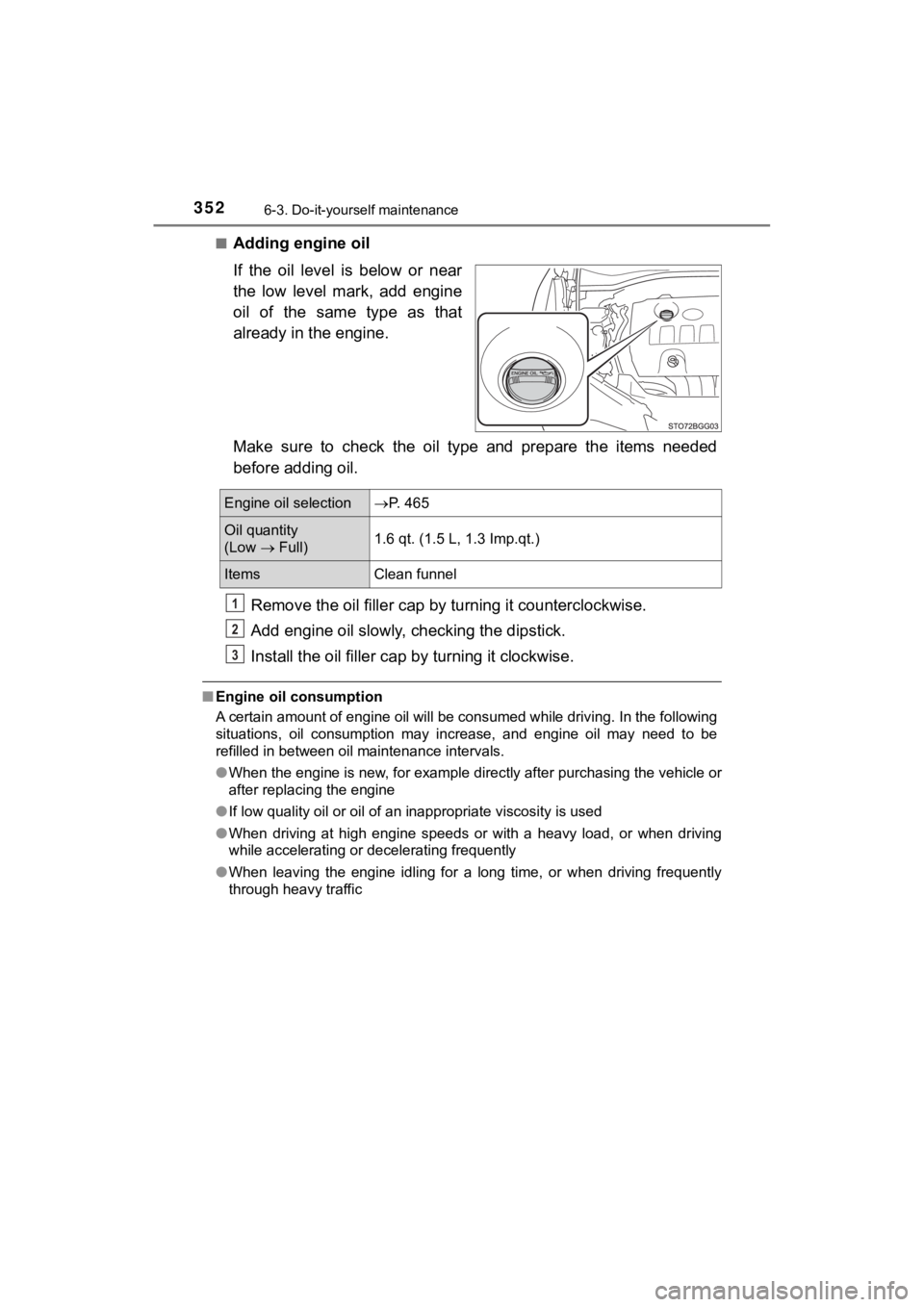
3526-3. Do-it-yourself maintenance
C-HR_OM_USA_OM10569U■
Adding engine oil
If the oil level is below or near
the low level mark, add engine
oil of the same type as that
already in the engine.
Make sure to check the oil type and prepare the items needed
before adding oil.
Remove the oil fille r cap by turning it counterclockwise.
Add engine oil slowly, checking the dipstick.
Install the oil filler cap by turning it clockwise.
■Engine oil consumption
A certain amount of engine oil will be consumed while driving. In the following
situations, oil consumption may increase, and engine oil may ne ed to be
refilled in between oil maintenance intervals.
● When the engine is new, for example directly after purchasing t he vehicle or
after replacing the engine
● If low quality oil or oil of an inappropriate viscosity is used
● When driving at high engine speeds or with a heavy load, or when driving
while accelerating or decelerating frequently
● When leaving the engine idling for a long time, or when driving frequently
through heavy traffic
Engine oil selection P. 465
Oil quantity
(Low Full) 1.6 qt. (1.5 L, 1.3 Imp.qt.)
Items
Clean funnel
1
2
3
Page 353 of 532
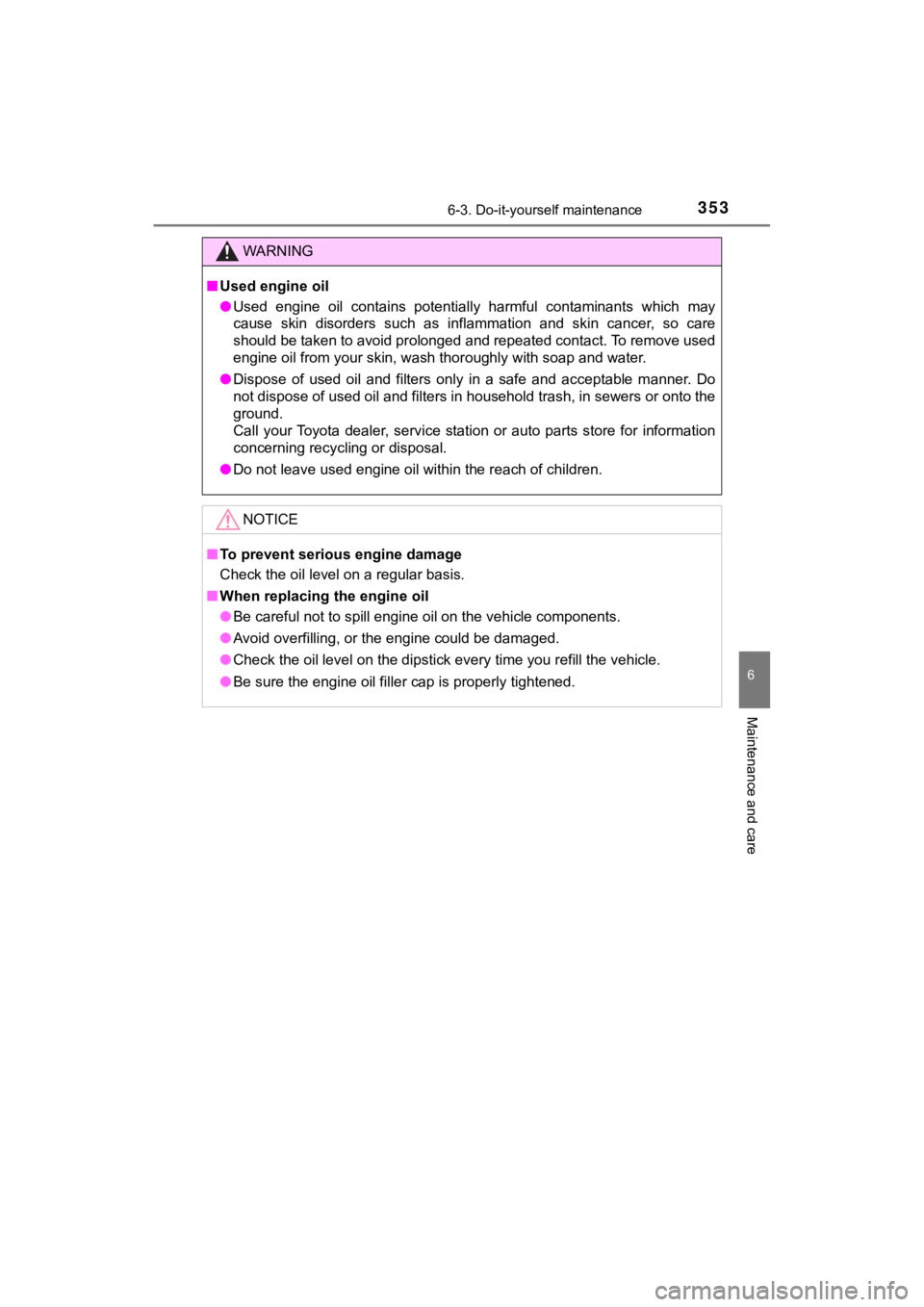
3536-3. Do-it-yourself maintenance
6
Maintenance and care
C-HR_OM_USA_OM10569U
WARNING
■Used engine oil
● Used engine oil contains potentially harmful contaminants which may
cause skin disorders such as inflammation and skin cancer, so c are
should be taken to avoid prolonged and repeated contact. To remove used
engine oil from your skin, wash thoroughly with soap and water.
● Dispose of used oil and filters only in a safe and acceptable manner. Do
not dispose of used oil and filters in household trash, in sewe rs or onto the
ground.
Call your Toyota dealer, service station or auto parts store fo r information
concerning recycling or disposal.
● Do not leave used engine oil within the reach of children.
NOTICE
■To prevent serious engine damage
Check the oil level on a regular basis.
■ When replacing the engine oil
● Be careful not to spill engine oil on the vehicle components.
● Avoid overfilling, or the engine could be damaged.
● Check the oil level on the dipstick every time you refill the v ehicle.
● Be sure the engine oil filler cap is properly tightened.
Page 354 of 532
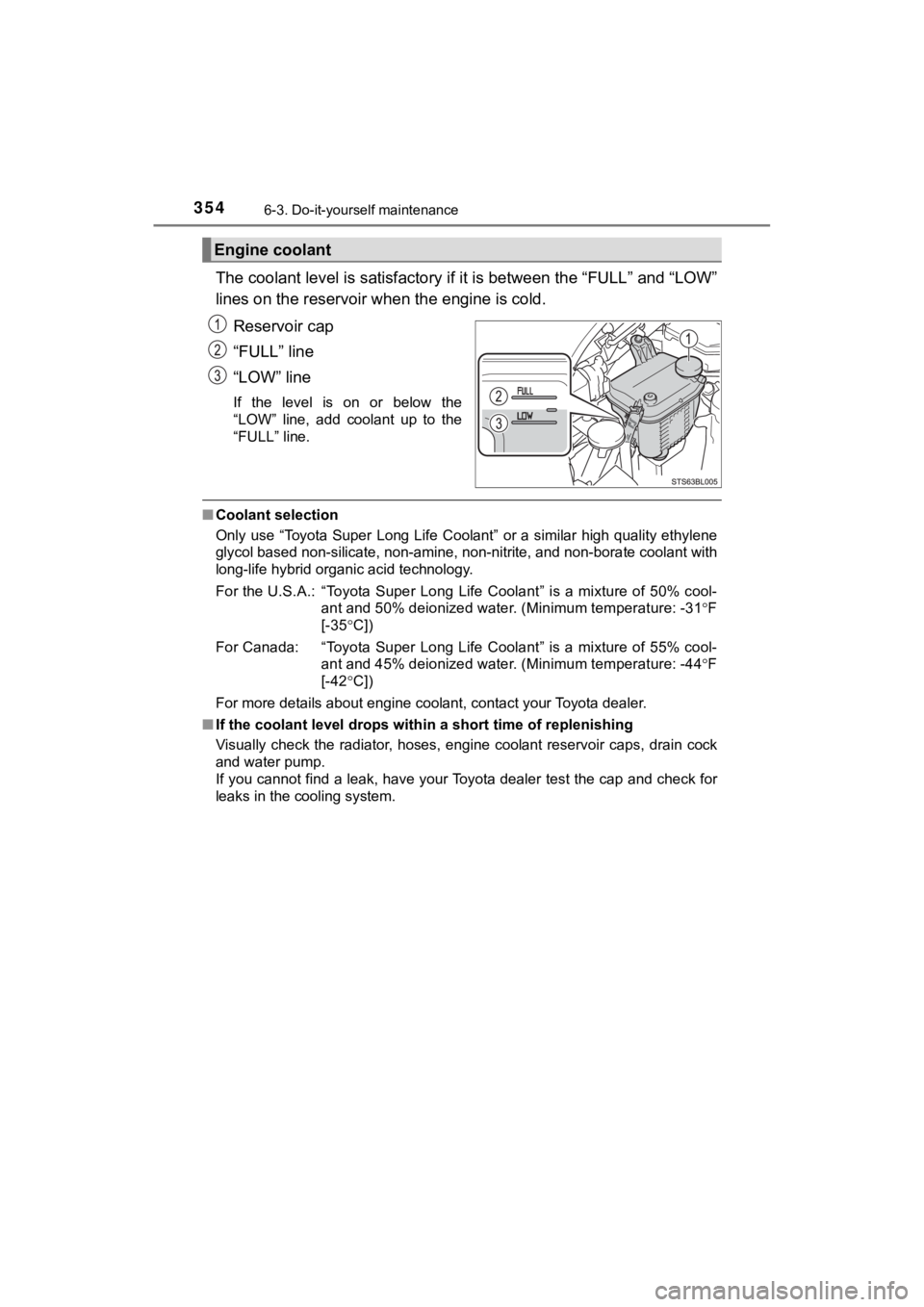
3546-3. Do-it-yourself maintenance
C-HR_OM_USA_OM10569U
The coolant level is satisfactory if it is between the “FULL” a nd “LOW”
lines on the reservoir wh en the engine is cold.
Reservoir cap
“FULL” line
“LOW” line
If the level is on or below the
“LOW” line, add coolant up to the
“FULL” line.
■ Coolant selection
Only use “Toyota Super Long Life Coolant” or a similar high quality ethylene
glycol based non-silicate, non-amine, non-nitrite, and non-bora te coolant with
long-life hybrid organic acid technology.
For the U.S.A.: “Toyota Super Long Life Coolant” is a mixture o f 50% cool-
ant and 50% deionized water. (Minimum temperature: -31 F
[-35 C])
For Canada: “Toyota Super Long Life Coolant” is a mixture of 55 % cool-
ant and 45% deionized water. (Minimum temperature: -44 F
[-42 C])
For more details about engine coolant, contact your Toyota deal er.
■ If the coolant level drops within a short time of replenishing
Visually check the radiator, hoses, engine coolant reservoir ca ps, drain cock
and water pump.
If you cannot find a leak, have your Toyota dealer test the cap and check for
leaks in the cooling system.
Engine coolant
Page 355 of 532
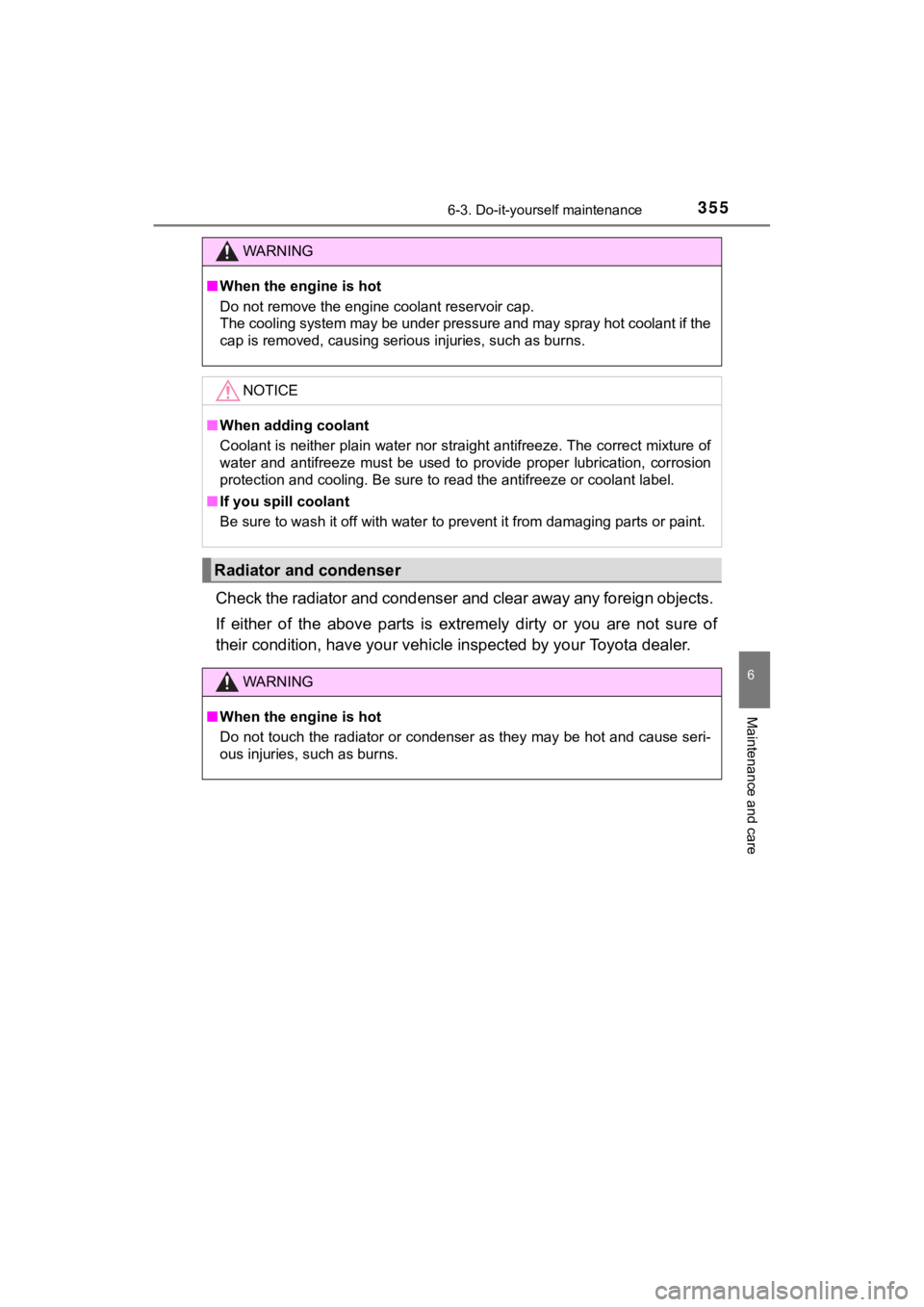
3556-3. Do-it-yourself maintenance
6
Maintenance and care
C-HR_OM_USA_OM10569U
Check the radiator and condenser and clear away any foreign objects.
If either of the above parts is extremely dirty or you are not sure of
their condition, have your vehic le inspected by your Toyota dea ler.
WARNING
■When the engine is hot
Do not remove the engine coolant reservoir cap.
The cooling system may be under pressure and may spray hot coolant if the
cap is removed, causing serious injuries, such as burns.
NOTICE
■When adding coolant
Coolant is neither plain water nor straight antifreeze. The cor rect mixture of
water and antifreeze must be used to provide proper lubrication , corrosion
protection and cooling. Be sure to read the antifreeze or coolant label.
■ If you spill coolant
Be sure to wash it off with water to prevent it from damaging p arts or paint.
Radiator and condenser
WARNING
■When the engine is hot
Do not touch the radiator or condenser as they may be hot and c ause seri-
ous injuries, such as burns.
Page 356 of 532
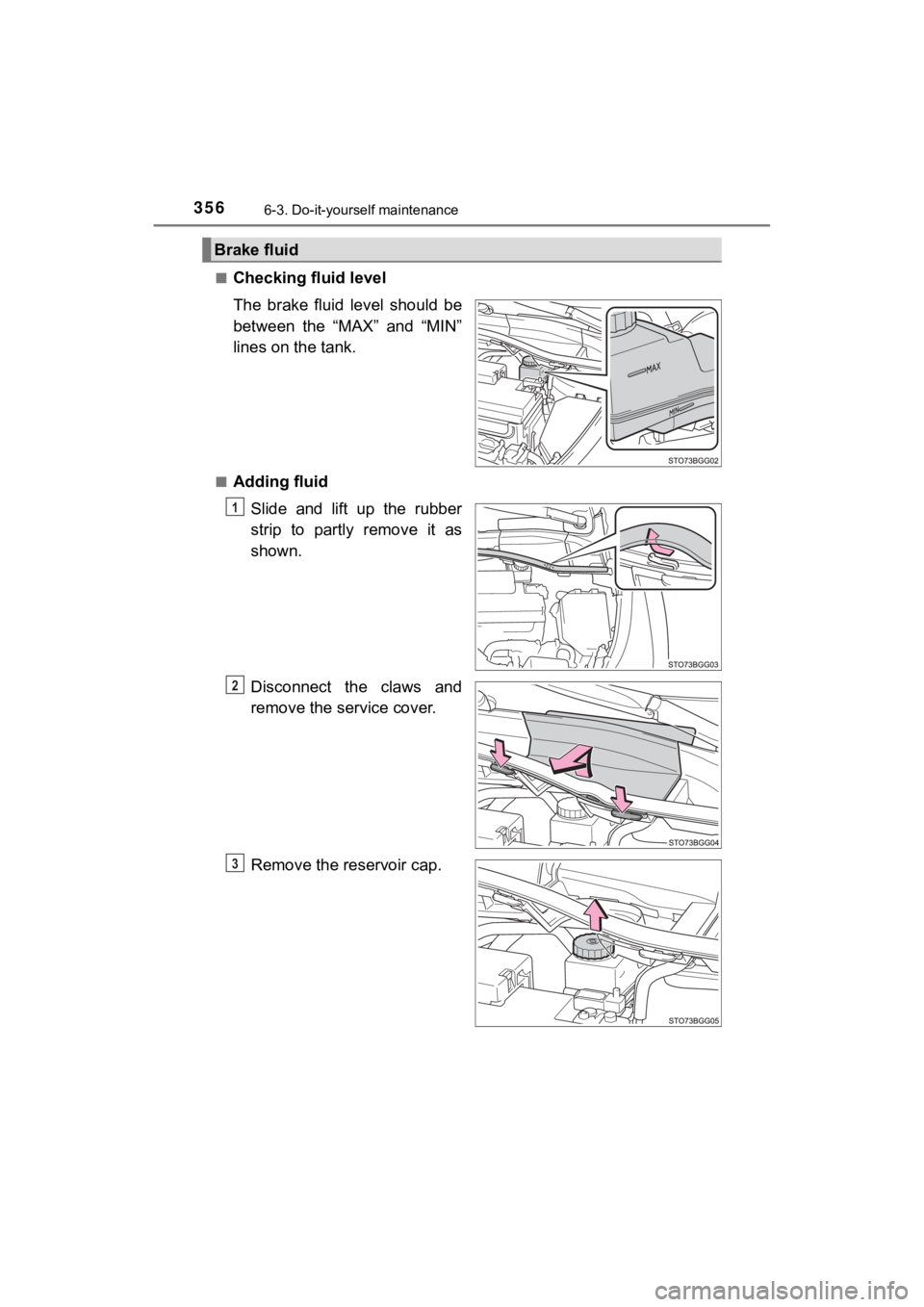
3566-3. Do-it-yourself maintenance
C-HR_OM_USA_OM10569U■
Checking fluid level
The brake fluid level should be
between the “MAX” and “MIN”
lines on the tank.
■Adding fluid
Slide and lift up the rubber
strip to partly remove it as
shown.
Disconnect the claws and
remove the service cover.
Remove the reservoir cap.
Brake fluid
1
2
3
Page 357 of 532
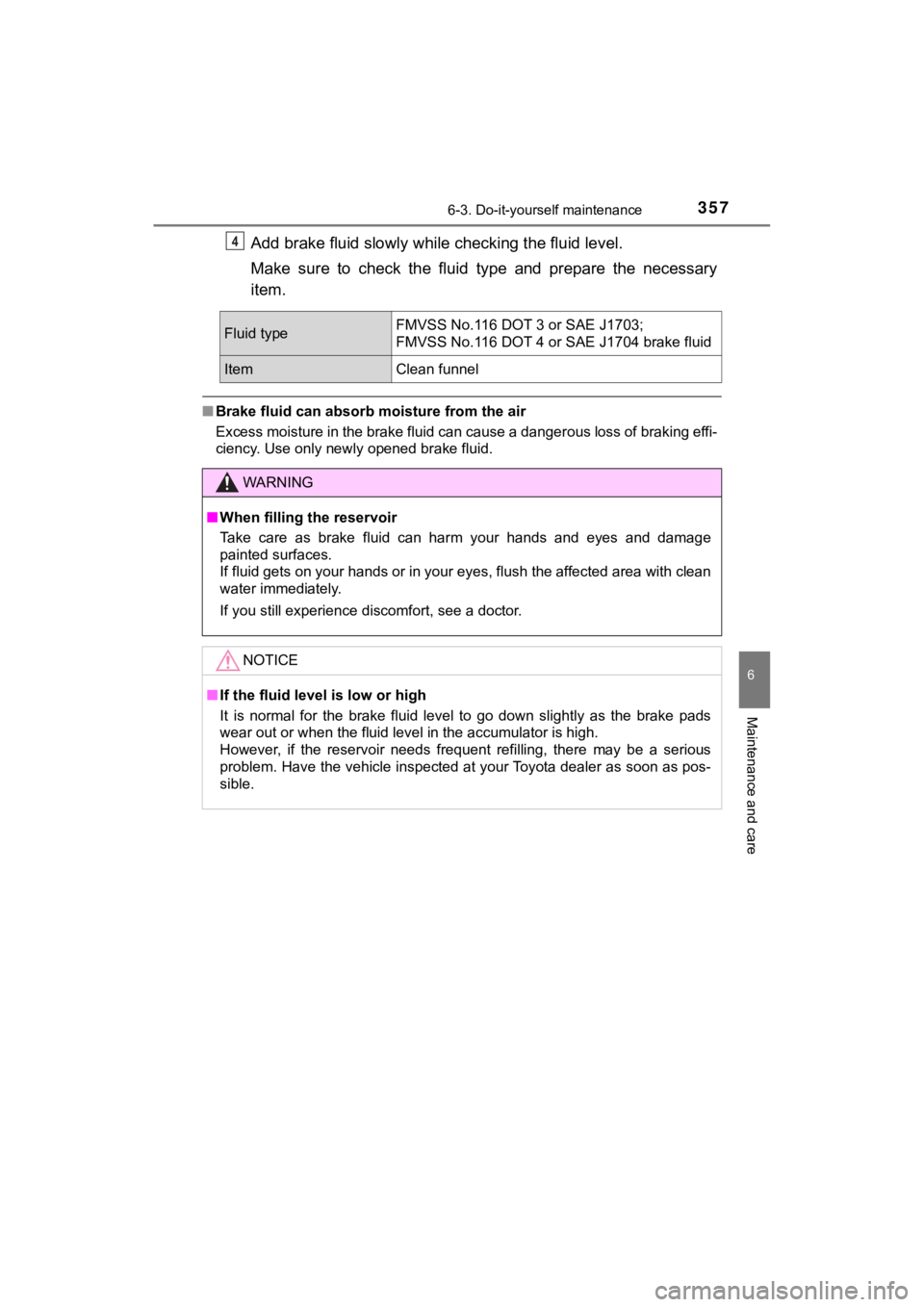
3576-3. Do-it-yourself maintenance
6
Maintenance and care
C-HR_OM_USA_OM10569U
Add brake fluid slowly while checking the fluid level.
Make sure to check the fluid type and prepare the necessary
item.
■ Brake fluid can absorb moisture from the air
Excess moisture in the brake fluid can cause a dangerous loss o f braking effi-
ciency. Use only newly opened brake fluid.
4
Fluid typeFMVSS No.116 DOT 3 or SAE J1703;
FMVSS No.116 DOT 4 or SAE J1704 brake fluid
ItemClean funnel
WARNING
■ When filling the reservoir
Take care as brake fluid can harm your hands and eyes and damag e
painted surfaces.
If fluid gets on your hands or in your eyes, flush the affected area with clean
water immediately.
If you still experience discomfort, see a doctor.
NOTICE
■ If the fluid level is low or high
It is normal for the brake fluid level to go down slightly as t he brake pads
wear out or when the fluid level in the accumulator is high.
However, if the reservoir needs frequent refilling, there may b e a serious
problem. Have the vehicle inspected at your Toyota dealer as soon as pos-
sible.
Page 358 of 532
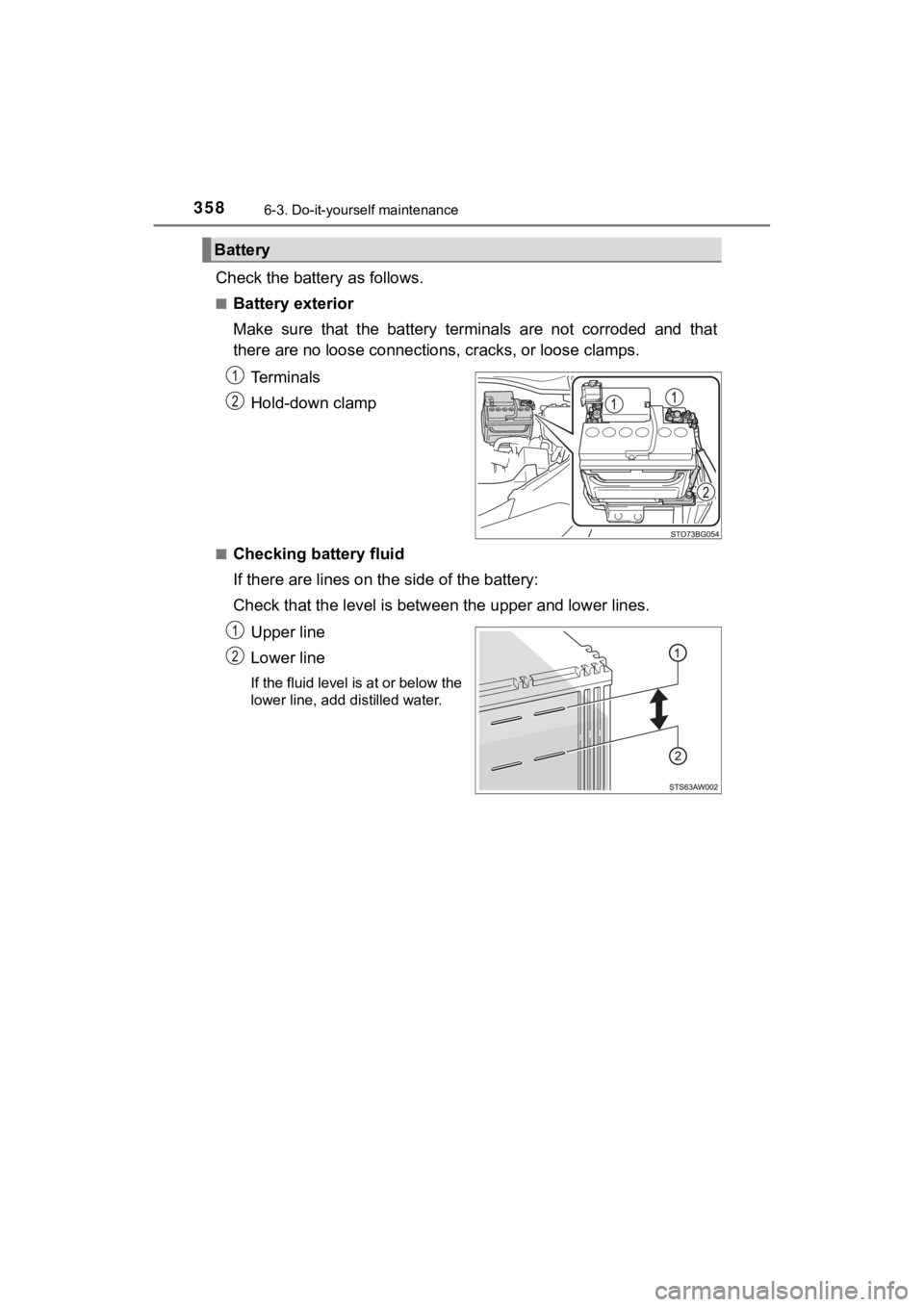
3586-3. Do-it-yourself maintenance
C-HR_OM_USA_OM10569U
Check the battery as follows.
■Battery exterior
Make sure that the battery terminals are not corroded and that
there are no loose connections, cracks, or loose clamps.
Terminals
Hold-down clamp
■Checking battery fluid
If there are lines on th e side of the battery:
Check that the leve l is between the upper and lower lines.
Upper line
Lower line
If the fluid level is at or below the
lower line, add distilled water.
Battery
Page 359 of 532
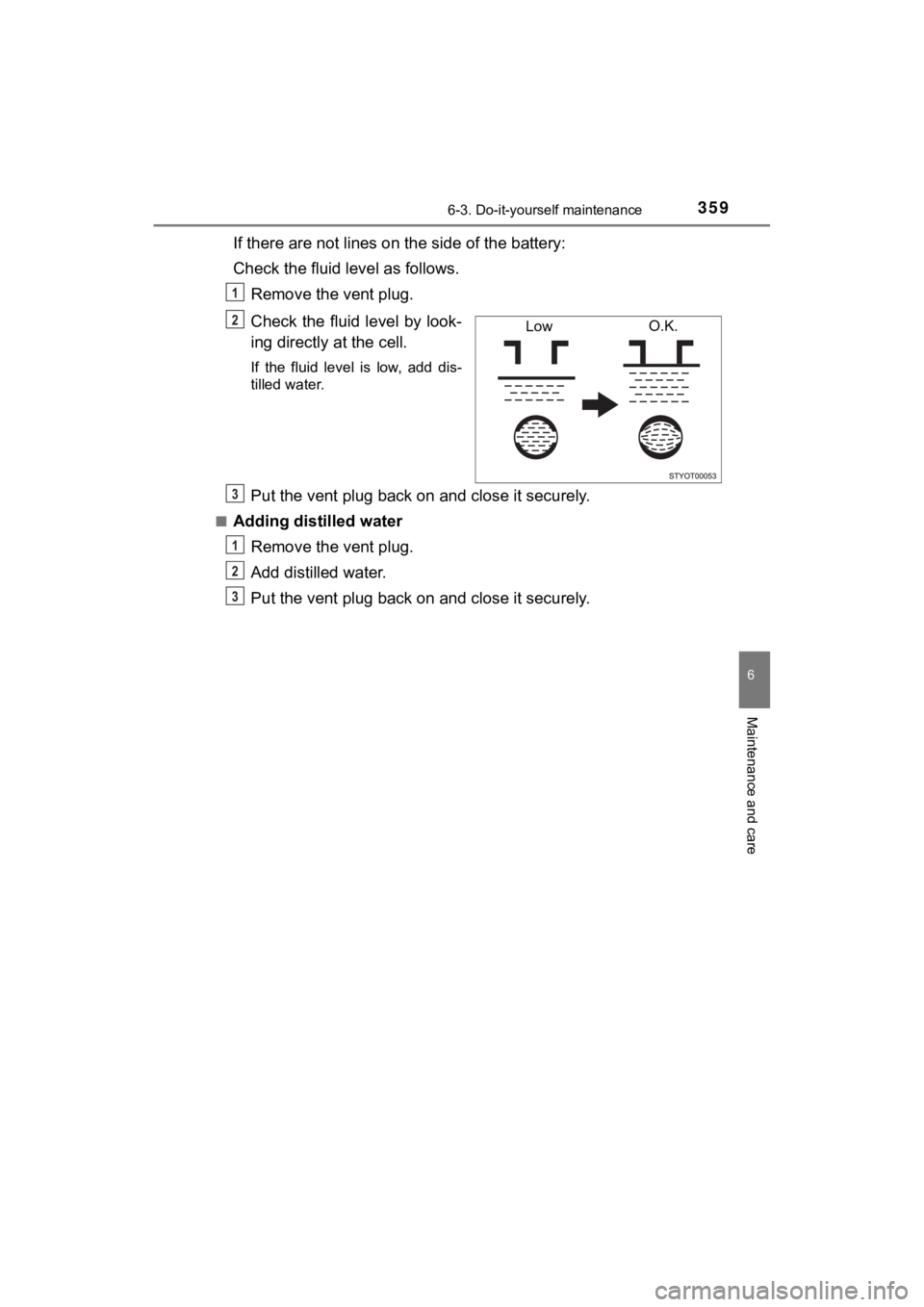
3596-3. Do-it-yourself maintenance
6
Maintenance and care
C-HR_OM_USA_OM10569U
If there are not lines on the side of the battery:
Check the fluid level as follows. Remove the vent plug.
Check the fluid level by look-
ing directly at the cell.
If the fluid level is low, add dis-
tilled water.
Put the vent plug back o n and close it securely.
■Adding distilled water
Remove the vent plug.
Add distilled water.
Put the vent plug back o n and close it securely.
1
LowO.K.O
P
N
O
P
Page 360 of 532
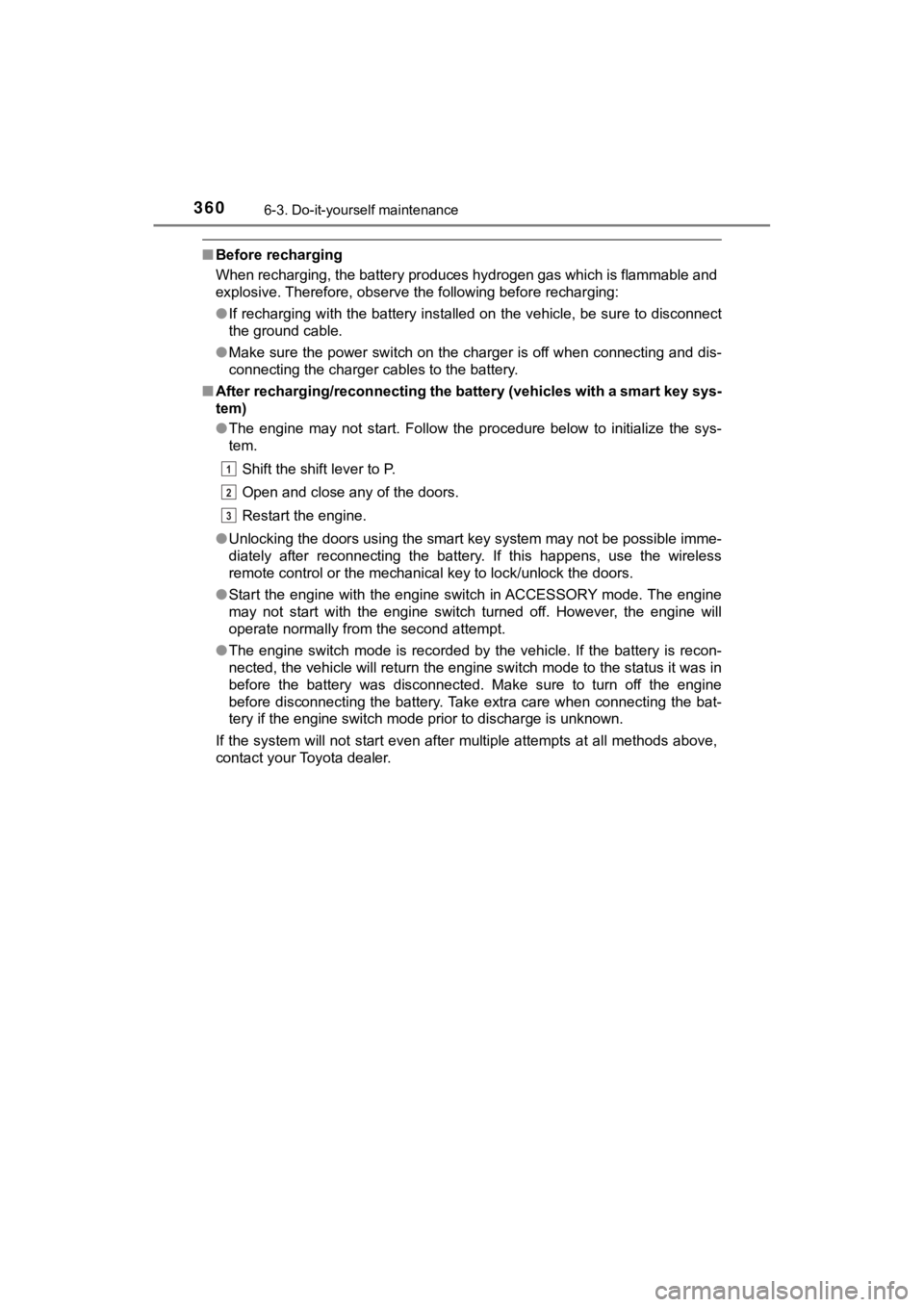
3606-3. Do-it-yourself maintenance
C-HR_OM_USA_OM10569U
■Before recharging
When recharging, the battery produces hydrogen gas which is flammable and
explosive. Therefore, observe the following before recharging:
●If recharging with the battery installed on the vehicle, be sur e to disconnect
the ground cable.
● Make sure the power switch on the charger is off when connectin g and dis-
connecting the charger cables to the battery.
■ After recharging/reconnecting the battery (vehicles with a smar t key sys-
tem)
● The engine may not start. Follow the procedure below to initial ize the sys-
tem.
Shift the shift lever to P.
Open and close any of the doors.
Restart the engine.
● Unlocking the doors using the smart key system may not be possi ble imme-
diately after reconnecting the battery. If this happens, use the wireless
remote control or the mechanical key to lock/unlock the doors.
● Start the engine with the engine switch in ACCESSORY mode. The engine
may not start with the engine switch turned off. However, the e ngine will
operate normally from the second attempt.
● The engine switch mode is recorded by the vehicle. If the batte ry is recon-
nected, the vehicle will return the engine switch mode to the s tatus it was in
before the battery was disconnected. Make sure to turn off the engine
before disconnecting the battery. Take extra care when connecti ng the bat-
tery if the engine switch mode prior to discharge is unknown.
If the system will not start even after multiple attempts at al l methods above,
contact your Toyota dealer.
1
2
3